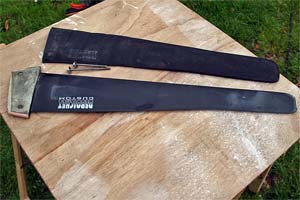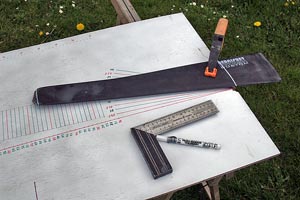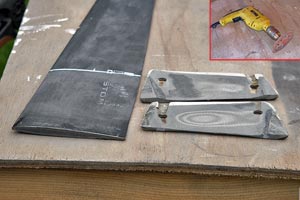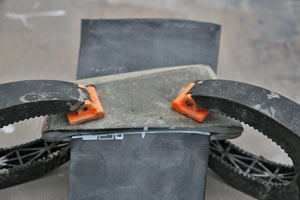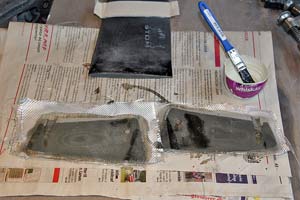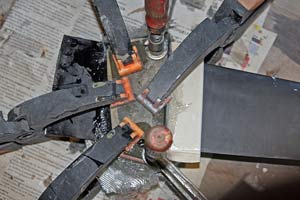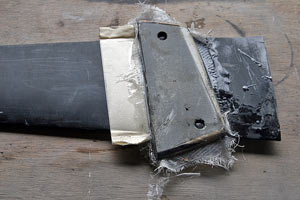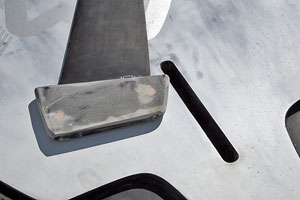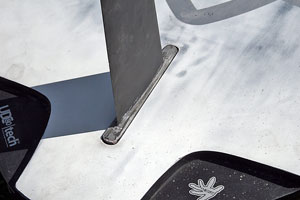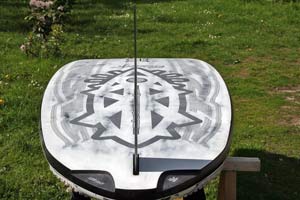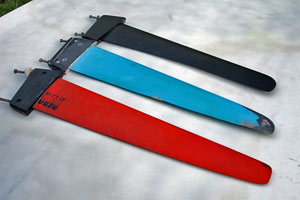|
DIY, converting your old formula fin to a big slalom fin.
Slalom sailing’s getting ever more popular, and especially the bigger slalom boards up to 85 cm width carrying sails up to 10 sqm. urge us to focus on the fin issue. Following the recent discussions on the beaches and on the windsurf forums you can almost make a parallel to the prosperous fin discussions between the formula sailors a couple of years ago. But contrary to the formula fin discussions, where you had a kind of starting point (the Deboichet R13), a lot of us seem to fumble in the dark for "the right" big-salom-fin-solutions. Slalom fins are indeed very different in performance (or performance emphasize), and you can easily have to buy 2, 3 or 4 slalom fins before you've got a chance to own the right fin for the purpose.
So, finding the right big slalom fin can be a somewhat expensive and frustrating process. What a shame that our old formula fins are just so outdated (i.e. too powerless for modern formula sailing) that it's mostly impossible to sell some of them to finance the buying of new slalom fins. These formula fins are just taking all the room in our fin boxes for no reason, and now they're almost worthless.
But wait a minute. All these Debo. R12, R13, R14, R16, R17 and comparable fins from Hurricane, Black Diamond etc. were in fact very good (for their time) and well built fins. Why not use this surplus of unused fins for some slalom fin experimentation? If you for instance have a look at the Debo. homepage it seems like the R16 formula fins and the R16 slalom fins are almost identical from the fin tip upwards, the only difference being where the manufacturer has cut the fin shaft and placed the fin head. It seems logical that you can imitate this cut-down (from the top, not from the tip!) and have a useable fin - or perhaps have a fantastic fin!
It’s NOT at all difficult to shorten a 70 cm formula fin to, say, a 50 cm slalom fin – but it’s perhaps a little time consuming with the hardening processes involved. The pictures below show ONE way of doing it, but other (and easier) ways involving more manageable resins are certainly also possible.
You can click all the pictures to have a more detailed view.
|
||
|
1. An old and well-used Deboichet R12 66 cm formula fin lies on the operation table, ready to be converted to a slalom fin for a RRD X-Fire 135 slalom board with a North Warp 9.0.
Click the picture to enlarge. |
2. The fin head is divided into two parts by means of a hacksaw. Of course the round brass nuts that hold the fin bolts are removed (pushed/tapped out), and the sawing has to be continued until you're through the fin head area.
Click the picture to enlarge. |
3. The (divided) fin head is separated from the fin shaft.
Click the picture to enlarge. |
|
4. The fin's now split into 3 parts - and you're ready to continue.
Click the picture to enlarge. |
5. You'll have to decide the fin length and the rake. IF you plan to repeat this slalom fin building process a couple of times, it can be helpful to spend half an hour to make a kind of fin measuring device including length and angle.
In this case the R12 slalom fin will have a rake of 80° and a length of 47 cm. The white line at the fin tip indicates that the fin tip is planned to be modified a little.
Click the picture to enlarge. |
6. In the inside of the two halves of the fin head you'll have to create room for the fin shaft. Using a power drill equipped with a sanding disk (see the inserted photo) it's done within 10 minutes (beware of the airborne debris/dust). Of course, other power devices can be used for this purpose.
Click the picture to enlarge. |
|
7. Checking whether the two fin head halves fit to the fin shaft. No need to be VERY precise as the bonding material (see next picture) fills the space ...
Click the picture to enlarge. |
8. A couple layers of glass weaves are placed in the inside of the two fin halves and wetted with some epoxy resin. Epoxy's the best, but styrene resin's probably all right too.
Click the picture to enlarge. |
9. The two fin head halves are placed in the right place of the fin shaft - and by means of some vices the parts are squeezed together. The surplus resin and glass automatically seeps into all the small cavities.
Click the picture to enlarge. |
|
10. The resin has hardened, the vices are removed, and the surpluss material's ready to be hacksawed away.
Click the picture to enlarge. |
11. Time to fit the fin head to the fin box of the board it's intended to be used with. You can probably see that the fin head in this case has been added a little filler material.
Click the picture to enlarge. |
12. The fin fitting process can be a little time consuming - but being patient and not removing too much fin head material at a time makes things much easier. Here the fin almost fits into the Tuttle box (the last couple of millimeters is a job for the fin bolts).
Click the picture to enlarge. |
|
13. Remember also to fit the fin in a way so that it's perpendicular to the bottom of the board.
Click the picture to enlarge. |
14. Time to place drill holes for the brass nuts and for the fin bolts. The easiest way to place the holes the right way is probably to use another fin for measurement, but other ways're certainly possible.
Here the fin's ready to use, and as can be seen the fin tip has been modified slightly.
Click the picture to enlarge. |
15. The black fin is "our" 47 cm 80° Debo. R12.
The blue fin is a 50 cm 80° Debo R13 M modified in almost the same way as the R12.
The red/orange fin is a 51.5 cm 81° Debo. R16 fin, modified by cutting off the fin head (without dividing it in halves), drilling/filing out space to the fin shaft - and assembling the head and shaft by means of some glass weave end styrene.
At the moment of writing the R16's the only fin that has actually been tested - and it quickly became the preferred fin for the manufacturer/owner (Yngve) when he rides his Starboard iSonic 133 with his Maui Sails TR5 9.2 XT.
Click the picture to enlarge. |
